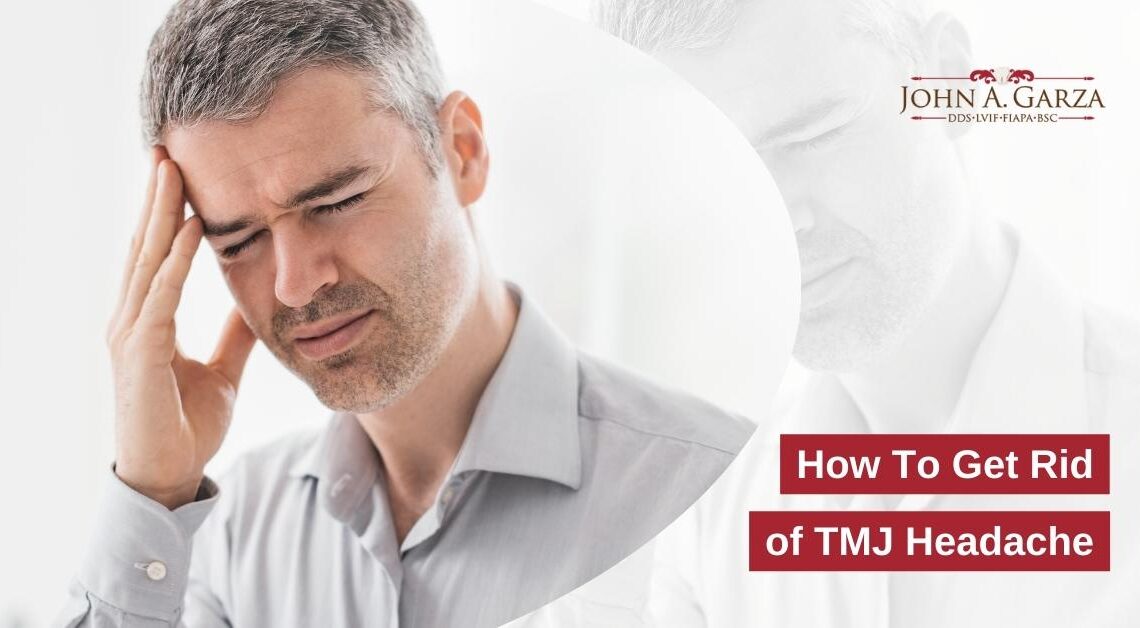TMJ headache, or Temporomandibular joint syndrome (TMJ) headache, is a head discomfort caused by tensing up the jaw muscles, spreading to the TMJ muscles along the side of your cheekbones, and eventually reaching the top of your head. It can sometimes be difficult to distinguish between TMJ pain and a regular headache.
The usual TMJ headache is a tight, dull, painful headache. It is most frequently found on one side, but it can occur on both. Typically, it is worse on the side with the severe TMJ. Jaw movement aggravates the headache, which subsides with jaw relaxation. Migraines, on the other hand, are more throbbing and acute. Additionally, they may be linked with various symptoms affecting feelings and eyesight.
Getting Rid of TMJ Headache
Face and jaw pain can be painful, and it’s made worse when you’re unsure of the source. There are numerous therapy options for TMJ. Your first line of defense is likely to be at home. However, if you’ve exhausted all at-home treatment options for your jaw, you may want further care from a physician.
Medical Treatment
Depending on the case, your doctor may prescribe you some strong medication. Additionally, they can advise you to wear bite protection (mouthguard). Clenching and grinding of the teeth are some common causes of TMJ headaches. A bite guard will protect your teeth from the clenching’s detrimental effects.
However, medicines and bite guards are not a long-term solution for TMJ disease. If you are not cautious and take the required precautions, the condition can revert.
TMJ headaches are inconvenient but can be managed with different medications. If you believe you may be suffering from TMJ headaches, discuss your symptoms with your doctor and any measures you’ve taken to lessen the pain, even if they weren’t effective.
Lifestyle changes
Modifying simple habits connected with your jaw can be beneficial, including the following:
- avoiding foods that are too firm or too chewy
- minimizing stress to avoid coping mechanisms such as jaw clenching
- preventing jaw motions caused by wide gaping or gum chewing
- To treat TMJ-related discomfort, short-term usage of nonsteroidal anti-inflammatory drugs (NSAIDs) can help alleviate jaw pain and headaches. Aspirin (Excedrin), ibuprofen (Advil), and naproxen all fall under this category (Aleve).
- Additionally, icing your jaw can help alleviate pain.
- Jaw exercises can assist in relaxing your muscles and relieving your pains.
Changes in your lifestyle may be sufficient to relax your muscles and alleviate discomfort. For instance, we may teach you how to stretch and massage your muscles and assist you in determining which motions or activities, such as chewing gum, worsen the problem. We know that minimizing daily stress is easier said than done, yet it is a critical component of treatment for our patients who clench their teeth regularly.
Your TMJ disorder may require treatment with an oral appliance. You’ll sleep with the device on your mouth like a mouthguard. It helps reduce teeth grinding, which may be the source of your TMJ symptoms, but oral appliances can also be used to realign a misaligned jaw gently.
Jaw Exercises to Relieve TMJ Pain
This straightforward relaxation exercise may help alleviate TMJ pain:
To begin, place your tongue beneath your front teeth in the upper region of your mouth. Then relax your jaw muscles and allow your teeth and tongue to separate slightly. Within minutes, you should feel relieved of tension. Other exercises, such as goldfish exercises, chin tucks, and side-to-side jaw movement exercises, may help you discover TMJ discomfort relief.
TMJ and Headaches
TMJ-related jaw pain is frequently misdiagnosed as tension or migraine headaches. Indeed, one study discovered that migraines caused by TMJ were misdiagnosed as tension headaches in 31% of patients studied.
Why are these two terms so easily confused? Because the jaw joint is directly connected to the skull via muscles. A large, fan-shaped muscle that covers either side of your head is one of the key muscles that move your jaw. Your cheeks include additional muscles connected with the temporomandibular joint.
When these muscles become stiff, knotted, or injured due to jaw joint disorders, they exert tremendous stress on the head, resulting in headaches.
The way your teeth come together when you bite also affects TMJ and accompanying headaches. When you have misaligned teeth that result in an uneven bite, the jaw is put under tension. Occasionally, the load is sufficient to knock the joints out of position. This abnormal pressure and movement in your jaw joint damage your muscles, resulting in headache pain.
However, it might be challenging to pinpoint the source of a TMJ headache. At times, it results from a combination of circumstances such as a jaw injury, rheumatoid arthritis, or genetics. Misaligned teeth are a common reason. Another is grinding one’s teeth. This frequently occurs during sleep. Grinding your teeth can also contribute to further complications such as loose teeth and jawbone erosion.
If lifestyle changes and medicines are ineffective at curing the TMJ headache, orthodontic surgery may be considered. These procedures modify the form of your bite permanently. On the other hand, orthodontic surgery is not a guaranteed permanent TMJ headache treatment.
Learn more about TMJ headache by contacting Garza DDS
If you are one of the many people who suffer from TMD and headaches, we hope this article has given you some relief. There is help available. Contact us today to schedule an appointment, and let us help you get on the path to healing. We offer a variety of treatment options that have been proven to reduce pain and restore function. Don’t wait any longer–get started on your journey to recovery!


